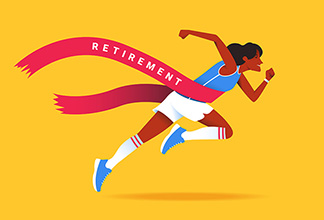Style is Personal, Whether Travelling or Investing
Written by Rita Silvan
Published on July 17, 2018
minute read
Share:
It's the time of year when there's a good chance your social-media feeds will be blowing up with enticing travel shots and tales. Maybe it'll be Instagram-worthy cruises and sunrise yoga sessions, or perhaps adventures in offbeat locations like diving at the Great Barrier Reef or kayaking among the icebergs in Greenland. Or possibly lower-key exploits focused on relaxation and luxury spots like Paris, Florence or the Bahamas. And, of course, there will likely be the "staycations" for those sticking close to home.
"Each travel style has its pros and cons; it's about choosing the one that suits you. Investing styles are no different."
Whether you're the one doing the posting, or just perusing, certain types of travel may appeal to you more than others. There are the adventurous, take-charge types who want to plan every detail and chart their own course, as well as the more relaxed, hand-the-reigns-over types who choose the locale and then go with the flow. Some of us favour a mix of both, of course, and styles can certainly change.
Each travel style has its pros and cons; it's about choosing the one that suits you. Investing styles are no different. Many like to debate the benefits of the two main types of portfolio management styles — active and passive. But is one better than the other?
Really, it comes down to an investor's specific situation, including risk tolerance, time horizon and performance expectations — all things that can change over time. Here's a closer look at some of the characteristics of each as they relate to equities and fixed-income portfolios.
Take Charge: Active Approaches
Equities: When it comes to stocks, active management tends to be more common than passive. Most active investors have one core goal: to outperform the market. What does an active style look like? Here are a few common active approaches for equity investors:
Growth-oriented: Investors here are looking for stocks with strong earnings growth compared to the overall market. Growth stocks can be relatively new, or in fast-growing industries, and typically don't pay dividends — with firms choosing instead to reinvest earnings into the business.
Value-oriented: Here investors are looking for undervalued stocks, the so-called bargain stocks that are trading at a lower price relative to fundamentals like earnings, book value and sales as compared to industry peers or an index. A value investor is generally prepared to hang onto a stock for the long term until it comes back into favour or its price reflects its true value.
Sector rotation: This approach starts with identifying specific sectors that are expected to perform well — and getting in before they actually start to take off. The general idea is that the economy operates in cycles, and some sectors perform better than others depending on how the overall economy is doing.
Fixed Income: Active approaches for fixed-income investors can include:
Interest rate anticipation: It's all about gauging where interest rates are going for these investors. When rates are expected to fall, interest rate anticipators would look to extend the duration of their bond holdings. Conversely, when rates are expected to rise, investors would want to shorten terms to maturity.
Slow it Down: Passive Approaches
Equities & Fixed-Income: Two common passive approaches apply to both equities and fixed income, including:
Buy-and-hold: As it sounds, equity investors who favour a buy-and-hold style choose to buy stocks and hold them for a long time, aiming for a gradual increase in value. Bonds would be held until maturing with this approach, which means avoiding interest-rate risk on early sales. Portfolio turnover is low with this approach.
Indexing: This strategy attempts to mimic the performance of a specific index by replicating its holdings. With stocks, investors could hold each stock in the same proportion to its weighting in an index, or a sampling of stocks that mimic an index. Of course, it's tough for an individual investor to hold all the component of an index, but there are index funds and ETFs that can help achieve this. With bonds, a portfolio would normally consist of a sample of index constituents in an attempt to replicate the index's performance.
What's your style? Largely it will be based on questions like:
"What is my risk tolerance?"
"What kind of returns am I aiming for?"
"How long do I have until I need the money?"
The answers can help you choose an investing style that suits your personality and needs to bring you peace of mind...just like knowing whether you'd prefer to vacation among the icebergs or sit back and sip a mojito on a sandy beach.
RBC Direct Investing Inc. and Royal Bank of Canada are separate corporate entities which are affiliated. RBC Direct Investing Inc. is a wholly owned subsidiary of Royal Bank of Canada and is a Member of the Investment Industry Regulatory Organization of Canada and the Canadian Investor Protection Fund. Royal Bank of Canada and certain of its issuers are related to RBC Direct Investing Inc. RBC Direct Investing Inc. does not provide investment advice or recommendations regarding the purchase or sale of any securities. Investors are responsible for their own investment decisions. RBC Direct Investing is a business name used by RBC Direct Investing Inc. ® / ™ Trademark(s) of Royal Bank of Canada. RBC and Royal Bank are registered trademarks of Royal Bank of Canada. Used under licence. © Royal Bank of Canada 2018. All rights reserved.
The views and opinions expressed in this publication are for your general interest and do not necessarily reflect the views and opinions of RBC Direct Investing. Furthermore, the products, services and securities referred to in this publication are only available in Canada and other jurisdictions where they may be legally offered for sale. If you are not currently resident of Canada, you should not access the information available on the RBC Direct Investing website.
Explore More

Should I Invest or Pay Down My Mortgage?
Consider these four questions
minute read

As Many Head Back to the Office, Where Could Investors See Changes?
How returning to in-person work could affect a range of investments
minute read

Considering the FIRE Lifestyle? Here’s What Your Investments Might Look Like
We asked three people how they created financial independence and retired early
minute read
Inspired Investor brings you personal stories, timely information and expert insights to empower your investment decisions. Visit About Us to find out more.







